Watermelons are a staple of summer fun. Biting into the juicy melon is one of the most refreshing things I can think of, and who can forget having contests as a child to see who can spit the watermelon seeds the farthest (or as an adult — I don’t judge!). But it takes a lot of work — and space — to grow watermelons. They grow on the ground, and rows are often spaced 6 to 8 feet apart on farms — so even if you’re trying to add watermelons to your garden, plan for growing watermelons with a lot of room around them.
I live near Gainesville, Florida, which offers the benefit of being near the land-grant University of Florida with a plethora of agricultural experts at my finger tips. And while Florida may be nationally well known for its oranges, it is actually an amazingly diverse state in terms of what it produces agriculturally. Think tomatoes, sugarcane, peanuts, and, of course, watermelons!
According to U.S. Department of Agriculture data from 2017, there are over 113,000 acres of watermelons grown nationally — and all of that totals more than 40 million pounds.
Watermelons have a lot going for them: For example, even though they are pollinated by bees and grow like a fruit, they are part of a botanical family of gourds that include cucumber and squash and have some more vegetable-like characteristics. And, though most people may be familiar with just the type of watermelons you buy at a local grocery store, there are actually about 1,200 different varieties of watermelons.
According to the Agricultural Marketing Resource Center, Texas, Florida, Georgia, and California are the most prominent states for commercial watermelon producing. So touring a watermelon farm here in Florida — and getting to better understand how watermelons are planted, grown, and harvested — was a priority for me.
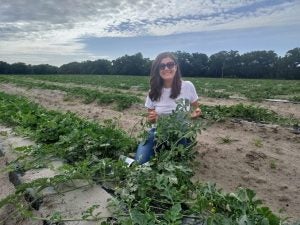
I spent the day with Dr. Tatiana Sanchez from the University of Florida’s Extension Office — she is an expert in horticultural crops and assists farmers in best management practices, primarily for pesticide use and water quality. And, boy, was it cool to learn about how they’re doing research to minimize inputs for farmers.
One of these inputs is fertilizer. In central Florida there are many natural springs in sandy soil (sandy soil, Sanchez says, is where watermelons grows best) with aquifers and no filtration, so protecting the planet here is especially delicate and important. Therefore you want to make sure too much nitrogen, phosphorus, or other elements aren’t leaching into the water.
How do they do this? By doing a tissue and sap test! That involves finding mature leaves, where nutrients are most stable, and examining them. Sanchez explains more in depth in this video:
Basically she takes the stem (known as the petiole) of the most mature leaf and collects about 15 samples. She then cuts them and puts them into a garlic press to squeeze the sap out of the plant. This process tells her how much nitrogen and potassium are present. Here’s a video of Sanchez performing a sap test:
As you can see by the video, the plants in this field have healthy levels of nutrients! If they didn’t, she would work with the grower to improve their practices and make sure everything is right where it needs to be.
Another part of her research is trying new products and evaluating change. These fertilizer “pellets” have a “slow release” nitrogen process, and Sanchez is trying to compare them to other fertilizer methods. Florida growing conditions mean that these watermelons grow really fast! So, timing is everything when it comes to plant nutrition, where each acre needs two pounds of nitrogen per day.
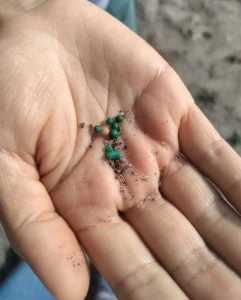
Timing is also everything when it comes to rain, drip tape irrigation and overall moisture — these crops are approximately 92 percent water, after all. A watermelon’s growing season usually starts in late spring/early summer and lasts for 70 to 85 days — basically, during some hot parts of the year. Sanchez utilizes these soil moisture sensors to monitor the water system, where the data is tied directly to her smartphone. Cool, huh? She wants to make sure there’s no irrigation leaks and to know that the water is in a healthy area to hit right in the root zone and maximize the soluble fertilizer.
This is what the sensor looks like:
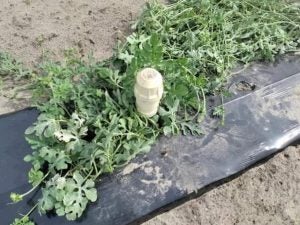
Monitoring moisture is also important for watermelon disease management and overall pest pressure. One of the most common diseases in Florida watermelons are a soil born fungus called fusarium, which is a foliar disease that seems to show up every year no matter what. Disease pressure can also be higher if the plant stems are buried too deep. In both organic and non-organic farming systems, farmers also usually have to spray broad spectrum fungicides for downy and powder mildew — it’s crucial to keep that plant foliage clean.
Other common watermelon pests include squash bugs that stab the crown of the plant, which can ultimately collapse it.
Sanchez is also an entomologist and one of the most knowledgeable people I’ve ever spoken to about bees! Experts like her work hard with watermelon growers to have a balanced ecosystem and protect them, so, oftentimes, pesticides are sprayed at night when bees are not foraging (just to be on the safe side.). Here is a bee at work!
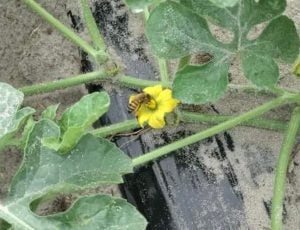
Most people recognize that bees are crucial to pollinating the food supply. A grower could have a flat of 100 plants where 10 are male and the rest are female, where the males are planted at random and start flowering at around four to six weeks. It is recommended that growers have around three to five bee hives per acre. While some farms have their own bees, others pay companies between $45 and $200 a hive depending on region. (It seems that everything is more expensive in California!) This is how commercial growers have advantages over gardeners who may not have access to the best and closest pollinators.
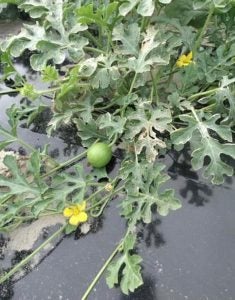
As you can see in the above image from mid-April, the watermelons are just starting to form, and when ready to harvest in Florida, professional crews show up in school buses during a two- to six-week period, when they work hard to hopefully conduct three to five harvests as the crop matures.
The number of harvests depends a lot on market price — if the farmer is paid well, they can afford to continue hiring workers and keep going. If market price is bad (supply and demand), they might not harvest as much. Often, their harvests are sold to brokers who then find buyers such as Walmart or Costco.
Below is a shot of farm workers who are flipping the vines over. Watermelon plants start from seed in a nursery and are transplanted outside when they are about five weeks old. They’re planted 2- to 2.5-inches deep and 2.5- to 3-feet apart to make room for them as they grow — even then, sometimes the vines grow into driveways reserved for the harvest trucks. The farm workers don’t want to run the crops over, so these guys come through and flip them get them out of the way of vehicles.
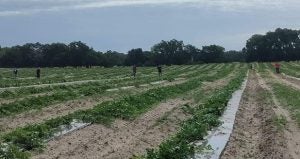
While watermelon production is a big deal in Florida, you may wonder what watermelon farming looks like in other parts of the country,
I spoke to watermelon grower Eric Jemmett from Southern Idaho — and, despite the significant differences in climate, the short answer is that there are definite similarities to what is done in Florida. He utilizes research, sap and nutrient testing, moisture monitoring, plants from a nursery, and plasticulture (the use of plastic materials to keep moisture in sandy or otherwise dry soil).
In addition to some differences in planting and harvest times, Jemmett also uses some different technology when compared to Florida — for example, he uses data from a technology sensor called Soiltech, which shares moisture content, humidity, soil temperature, bruising, and GPS transport, among other things.
These data points are crucial. Watermelon generally need to grow in temperatures between 32 and 88 degrees Fahrenheit, so anything below that can kill the plant, and any temperature above that can slow or stop plant growth. This is why Florida watermelons get growing as early as April, where the Idaho growers won’t even start transplanting until mid-May. For Jemmett, he’ll start his first harvest at the beginning of July.
How does a watermelon grower like Jemmett know when to harvest? Watermelon plants have two curly tendrils and a tiny leaf near the base stem of the plant, and when those start dying and drying up, it’s time to harvest! Growers don’t want to wait too long though, because if the melons over ripe, they could pop open, especially during harvest when the crews transport them into bins.
Planting and harvesting early also can usually fetch the grower a higher price.
So as you can see, there is a lot of steps involved in caring for these plants! The next time you enjoy a deliciously healthy watermelon, you can now have a better understanding of how they’re grown.
Michelle Miller, the Farm Babe, is a farmer, public speaker and writer who has worked for years with row crops, beef cattle, and sheep. She believes education is key in bridging the gap between farmers and consumers.



